Open-source video game
An open-source video game, or simply an open-source game, is a video game whose source code is open-source. They are often freely distributable and sometimes cross-platform compatible.
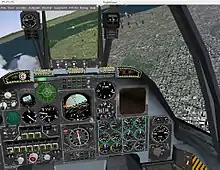
Definition and differentiation
Not all open-source games are free software; some open-source games contain proprietary non-free content. Open-source games that are free software and contain exclusively free content conform to DFSG, free culture, and open content and are sometimes called free games. Many Linux distributions require for inclusion that the game content is freely redistributable, freeware or commercial restriction clauses are prohibited.[1]
Background
In general, open-source games are developed by relatively small groups of people in their free time, with profit not being the main focus. Many open-source games are volunteer-run projects, and as such, developers of free games are often hobbyists and enthusiasts. The consequence of this is that open-source games often take longer to mature, are less common[2] and often lack the production value of commercial titles.[3] In the past (before the 2000s) a challenge to build high-quality content for games was the missing availability or the excessive price for tools like 3D modeller or toolsets for level design.[4] In recent years, this changed and availability of open-source tools like Blender, game engines and libraries drove open source and independent video gaming.[5] FLOSS game engines, like the Godot game engine, as well as libraries, like SDL, are increasingly common in game development, even proprietary ones.[6] Given that game art is not considered software, there are no philosophical or ethical obstacle in selling a game where its art is copyrighted and the entire source code is free software.[7][8]
Some of the open-source game projects are based on formerly proprietary games, whose source code was released as open-source software, while the game content (such as graphics, audio and levels) may or may not be under a free license.[9] Examples include Warzone 2100 (a real-time strategy game)[10] and Micropolis (a city-building simulator based on the SimCity source code). Advantage of such continuation projects is that these games are already "complete" as graphic and audio content is available, and therefore the open-source authors can focus on porting, fixing bugs or modding the games.
In a 2004 article, Adam Geitgey questioned the compatibility of the open-source culture with respect to the game development process. He suggested that perceived open-source development advantages do not work for games because users move on to new games relatively quickly and so do not give back to the project. Geitgey further noted that music and art development is not built up from the work of others in the same way that coding would be. He argued that high quality art content is required, which is typically produced commercially by paid artists. While Linux operates on the open-source philosophy, this may not benefit game development.[11]
As of September 2015, the Steam gaming service has 1,500 games available on Linux, compared to 2,323 games for Mac and 6,500 Windows games.[12][13][14]
History
Beginnings and early games
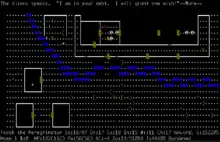
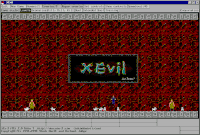
Just as in most other forms of software, free software was an unconscious occurrence during the creation of early computer games, particularly for earlier Unix games. These are mostly original or clone arcade games and text adventures. A notable example of this is BSD games, a collection of interactive fiction and other text-mode titles.[15] Game fan communities such as the modding community do include some aspects of free software, such as sharing mods across community sites, sometimes with free to use media made for the modification. With the rise of proprietary software in the mid to late 1980s, games became more and more proprietary. However, this also led to the first deliberately free games such as GNU Chess of the GNU Project, part of whose goal is to create a complete free software system, games included.[16] More advanced free gaming projects emerged, such as NetHack and Netrek, many still developed and played today in front-ends such as Vulture's Eye.
As PC gaming began to rise in the late 1980s and early 1990s, free gaming also advanced. More complicated games utilizing the X Window System for graphics started to emerge, most beginning with the signature letter X. These included XBill, XEvil, xbattle, Xconq and XPilot. XBill is notable as one of the earliest free gaming titles to feature an activist theme of halting proprietary software adoption. This theme was echoed in later titles such as FreeDroidRPG. XEvil followed the development cycle of many early pieces of free software, having originally been developed as a university project, although it was freeware for a while. The game was also one of the first free titles to feature controversial subject matter such as graphic violence and drug use.[17] Rocks'n'Diamonds is another earlier free software game, and one of the first for Linux.
The Freeciv project was started in 1995 and gave rise to another new style of free game development. Similar to the cooperative nature of the Linux kernel development, Freeciv was extended by many volunteers, rather than only one or two authors.[18] It had started out as a small university student project but then branched out into its current form and is still being developed today. Freeciv also proved to be one of the earliest very popular free software games, and was among the first to be included with Linux distributions, a system commonly known now as a source of peer review or selection of quality for free gaming projects. Magazines, news sources and websites have also started noting free games, often in listings.[19][20][21][22] Freeciv and other archetypes have led to the development of many other clones of popular proprietary games.[23] BZFlag, first worked on a few years earlier, is another project that had humble beginnings but grew into a popular and heavily developed project.
3D games and source releases
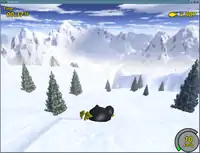
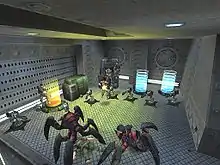
Proprietary games such as Doom and Descent brought in the age of three-dimensional games in the early to mid 1990s, and free games started to make the switch themselves. Tuxedo T. Penguin: A Quest for Herring by Steve Baker, a game featuring the Linux mascot Tux, was an early example of a three-dimensional free software game. He and his son Oliver would later create other popular 3D free games and clones such as TuxKart and contribute to those by other developers such as Tux Racer. The Genesis3D engine project, Crystal Space and Cube also spawned other 3D free software engines and games. FlightGear is another good example, especially noting that it is not a shooter engine but a flight simulator.[24]
id Software, an early entrant into commercial Linux gaming, would also prove to be an early supporter of free gaming when John Carmack released the source code for Wolfenstein 3D and Doom, first under a custom license and then later the GNU General Public License (GPL). This was followed by the release of Quake engine, id Tech 2, id Tech 3 and most recently id Tech 4. This led not only to source ports that allowed the playing of the non-free games based on these engines (plus fan added enhancements)[25] on free engines and systems, but also to new free games such as Freedoom, Nexuiz/Xonotic, Tremulous, and OpenArena.[26] Freeware games, such as Alien Arena, Warsow, World of Padman and Urban Terror,[27] have also taken advantage of these free engines and sometimes have given code back to the community. id Tech 4 was released as free software, even amongst patent concerns from Creative Labs. Development and editing tools are also commonly released freely, such as GtkRadiant.[28]
id partners and related, such as Raven Software, Bungie and 3D Realms, as well as several of the developers who participated in the Humble Indie Bundle,[29] have also released code and it is now accepted practice for some mainstream game developers to release legacy source code.[23] Formerly proprietary games such as Jump 'n Bump, Meritous, Warzone 2100, HoverRace and Abuse have even been entirely released freely, including multimedia assets and levels. Some games are mostly free software but contain some proprietary content such as the Cube sequel, Sauerbraten or the former Quake III Arena mod Smokin' Guns, but some developers desire and/or work on replacing these with free content.[30] Primarily proprietary developers have also helped free gaming by creating free libraries. Loki Software helped create and maintain the Simple DirectMedia Layer and OpenAL libraries and Linux Game Publishing created and maintain the free network layer Grapple. LGP also avoids publishing games similar to popular free titles.[31] Many libraries/infrastructures have been created without corporate assistance however, such as the online gaming system GGZ Gaming Zone. In addition, various game creators are free software such as the ZZT remake MegaZeux, versions of Game Editor, the GameMaker inspired G-Creator, Godot, Construct and ZGameEditor.
Rise in popularity and diversity
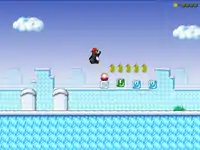
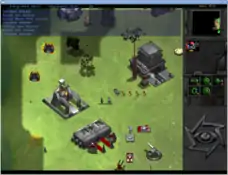
Individuals and teams have continued creating many popular free software games, starting really in the late 1990s to the present day. Many of these are clones such as Pingus (Lemmings clone), SuperTux and Secret Maryo Chronicles (Super Mario Bros.–inspired),[32] WarMUX and Hedgewars (Worms) as well as Frets on Fire, which is a recreation of Guitar Hero. A number of these games and those mentioned earlier and later in this section have even received mainstream press coverage[33][34] and have helped to establish free gaming as a moderately popular pastime, even if mostly enjoyed by Linux and BSD users. Frozen Bubble, originally a clone of Puzzle Bobble, has become a classic known for its addictive gameplay and winner of many Linux Journal Reader's Choice Awards.[35][36][37] These games and others have also helped expand the prevalent Tux genre which started with titles and like A Quest for Herring and are related to the activist content of games like XBill. More original games like Neverball, another 3D title, have also been able to carve out their own niches.[38][39]
Strategy games have also been a prevalent force in free software gaming,[32] partly due to the lack of proprietary strategy games for free software operating systems as compared to other genres like first-person shooters and role-playing games.[23] Freeciv began the trend, and was followed by other clone titles like FreeCol, Lincity and Widelands. The Stratagus project began as an attempt to recreate the proprietary Warcraft II engine, under the name FreeCraft. Blizzard Entertainment sent a cease and desist letter in 2003 over the use of the name "craft" in comparison to Warcraft and StarCraft.[40] Though the earlier free software strategy game CRAFT: The Vicious Vikings shared the name "craft" without controversy.[41]
With the new, legally inoffensive name Stratagus, the team began work on a new strategy game called Bos Wars. Development on this game still continues, as well as the modern Warcraft II port Wargus. Other games branched out of the engine project as well such as the Battle for Mandicor and Astroseries projects and the StarCraft port attempt Stargus. After the Stratagus example, other real-time strategy games were developed, such as Globulation 2, which experiments with game management mechanics, 0 A.D., a former freeware project, and the 3D projects Spring and Glest.[42] In addition, the more economically driven strategy game Widelands bases itself upon the proprietary Settlers franchise.
Racing games, another uncommon Linux commercial genre, has also seen development with TORCS and VDrift, as well as the Mario Kart–inspired SuperTuxKart. WorldForge is another example of increasing diversification, in its attempt to create a free massively multiplayer online role-playing game. Free software is also the main source for educational and children's software specifically for Linux, usually utilizing the child appeal of the Tux mascot, such as Tux Paint, Tux, of Math Command, Tux Typing and related efforts.[43]
The rise of the independent game development in the 2000s was partly driven by the growing ecosystem of open-source libraries and engines; indie developers utilized the open-source ecosystem due to good cross-platform capabilities and availability for limited financial burden.[5]
Greater organization
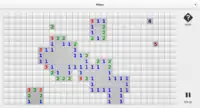

Despite its initial roots as small private projects, the free software gaming scene has been becoming progressively more organized. The roots of this even go back as far as the games created for the GNU Project and to the original larger-scale free software projects like Freeciv. Still, for the most part free game development had very little organization throughout its history. Popular games were generally separate efforts, except for instances of people working on them known for other projects such as Ingo Ruhnke, Bill Kendrick and Steve Baker. Games were commonly found in directories such as The Linux Game Tome and Freshmeat and hosted on sites like SourceForge, but they were largely only ever brought together in the form of disorganized lists. Other projects and games existed purely on small isolated personal or project websites, often unknown and ignored.
The launch of the GNOME and KDE desktop projects in the late 1990s organized application and, to a certain extent, game development. Both attempts to create a more usable Linux desktop attracted volunteers to make utilities to that end. These programs included games, mostly recreations of small games like Minesweeper or Solitaire that come with Microsoft Windows, arcade classics and the like, games from combined packs such as Microsoft Entertainment Pack, and occasionally original ideas. The variety and amount of these games, and other free games easily found in software repositories, have even led some to call GNOME or KDE-enabled Linux a better option for out of the box casual gaming than Microsoft Windows.[44] Examples include gbrainy, GNOME Mines and KAtomic. Many such games are packaged into GNOME Games and kdegames. The availability of free game engines, such as Stratagus, Pygame, Sauerbraten and ioquake3 have also helped unify free software development by making the engine projects themselves hubs of activity for games that make use of them.
The Battle for Wesnoth project was started in 2003 and quickly became popular to both players and editors. It also showcased some new ideas when it came to free game development. Like Freeciv before it, it utilized the efforts of the gaming and free software community and their code, levels and artwork contributions but it also accepted storyline contributions and ideas for the game's entire fictional universe. The game's canon is maintained through review and discussion over which submitted campaigns become official, thus setting up a model for community input and organized results.[45] This helped the game grow in scale and popularity to the point of being almost saga-like in scope. In addition, the project is worked on by many well-known free programmers, artists, designers and musicians such as the co-founder of the Open Source Initiative Eric S. Raymond,[46] and Linux kernel hacker Rusty Russell.[47][48] Vega Strike has similarly allowed its community to expand the game and the surrounding lore while maintaining canon consistency.
Hubs and development teams
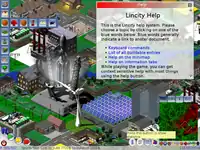
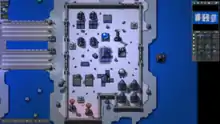
The general lack of unity and organization has created and continues to generate some controversy among the free software community, with problems of "reinventing the wheel" by making similar clones, games and multimedia resources being cited as a notable problem to free game development.[50] This is especially taking up more notice as other problems are corrected, such as a lack of tools, libraries, artists and coders. A more central knowledge bank, texture library, and discussion area have been called for several times.
Traditionally free software video games were developed as individual projects, some small scale and others larger scale. Programmers and other developers did often work on other projects, but the whole system was very unlinked. More recently free software development teams have started appearing, groups that function like software companies and create multiple pieces of work. Examples include the developer Parallel Realities, which have released the games Project: Starfighter, The Legend of Edgar, Blob Wars: Metal Blob Solid, as well as its sequel, Blob Wars: Blob and Conquer.[51]
In recent years, content repositories such as OpenGameArt.org and The Freesound Project have enabled developers to easily find appropriately-licensed content rather than relying on programmer art. Such content is often under Creative Commons licenses or those in the GNU GPL family, easily facilitating use by most free software projects.
The Linux Game Tome "Game of the Month" team was an open group of game developers that revamp old free software games. Some examples include the transformation of TuxKart into the more modern SuperTuxKart, work on Pingus and SuperTux, and Lincity-NG, an updated version of Lincity with superior graphics.[52]
GitHub now hosts a significant amount of free and open-source games.[53][54][55]
See also
- List of open-source video games
- List of commercial video games with available source code
- List of freeware video games
References
- "Software Packages in 'stable', games section". Debian. Retrieved 20 July 2022.
- Tozzi, Christopher (10 December 2013). "Linux Foundation, Valve Promote Open Source Games for the Cloud". The VAR Guy. Archived from the original on 24 May 2014. Retrieved 23 May 2014.
- Larabel, Michael (13 June 2012). "Most Open-Source Game Artwork is Awful". Phoronix. Archived from the original on 7 May 2016. Retrieved 14 September 2016.
- Hargreaves, Shawn (July 1999). "Playing the Open Source Game". talula.demon.co.uk. Archived from the original on 10 October 2011. Retrieved 20 July 2022.
- Blake, Michael (22 June 2011). "PC Gaming: Doomed? or zDoomed?". IGN. Archived from the original on 21 February 2014. Retrieved 20 July 2022.
- Dealessandri, Marie (15 April 2020). "What is the best game engine: is Godot right for you?". GamesIndustry.biz. Retrieved 20 July 2022.
- Stallman, Richard. "Nonfree DRM'd Games on GNU/Linux: Good or Bad?". GNU Project. Retrieved 2 August 2020.
- Marchant, Julie. "The Gaming Trap". The Diligent Circle. Archived from the original on 25 November 2019. Retrieved 25 March 2021 – via GitHub Pages.
- Matthews, Matt (31 August 2002). "Linux Games". Freshmeat. Archived from the original on 17 October 2002. Retrieved 20 July 2022.
- "About". wz2100.net. Archived from the original on 1 July 2013. Retrieved 20 July 2022.
- Geitgey, Adam (31 August 2004). "Where are the Good Open Source Games?". OSnews. Retrieved 13 April 2010.
- Newman, Jared (21 September 2015). "Steam for Linux tops 1,500 games as launch of Valve's Steam Machines nears". PC World. Retrieved 20 July 2022.
- Orland, Kyle; Machkovech, Sam (15 October 2015). "Steam's living room hardware blitz gets off to a muddy start". Ars Technica. Retrieved 20 July 2022.
- Orland, Kyle (26 February 2015). "The state of Linux gaming in the SteamOS era". Ars Technica. Retrieved 20 July 2022.
- Gagné, Marcel (1 September 2000). "The Ghost of Fun Times Past". Linux Journal. Archived from the original on 7 June 2011. Retrieved 20 July 2022.
- Stallman, Richard. "Linux and the GNU System". GNU Project. Archived from the original on 19 March 2017. Retrieved 20 July 2022.
- "Entry: XEvil". Home of the Underdogs. Archived from the original on 29 September 2007. Retrieved 20 July 2022.
- Wen, Howard (21 November 2001). "Building Freeciv: An Open Source Strategy Game". LinuxDevCenter.com. Archived from the original on 29 December 2008. Retrieved 14 April 2009.
- "Top 100 Free Linux Games". LinuxLinks. 8 February 2009. Archived from the original on 6 February 2010. Retrieved 20 July 2022.
- Menga, Rich (6 January 2009). "16 Free Games - Part 1". PCMech. Archived from the original on 22 June 2009. Retrieved 20 July 2022.
- Sbarski, Peter (21 January 2008). "Top 5 best (free) open source games". APC. Archived from the original on 10 February 2010. Retrieved 20 July 2022.
- Gatlan, Sergiu (12 November 2008). "Six Free and Must Have Games for Your Mac". Softpedia. Archived from the original on 13 December 2009. Retrieved 20 July 2022.
- Monks, Neale (29 November 2007). "Open Source Mac Gaming: 10 Free Games Reviewed". Tidbits. Archived from the original on 15 May 2010. Retrieved 20 July 2022.
- Maria (17 September 2008). "Top 5 Free Linux Games – Download Now". ixibo. Archived from the original on 26 January 2010. Retrieved 20 July 2022.
- Chakraborty, Angsuman (20 August 2007). "How To Play Doom, Heretic, Hexen & Strife in Linux (Free)". The Gaea Times. Archived from the original on 15 April 2012. Retrieved 20 July 2022.
- MrCopilot (17 December 2007). "Free Quake: Open Source Gamer's Guide to Free Games". Yahoo! Voices. Archived from the original on 19 June 2014. Retrieved 20 July 2022.
- Sepht (29 December 2007). "Comparison of free software shooters". linuX-gamers.net. Archived from the original on 7 January 2010. Retrieved 20 July 2022.
- "GPL GtkRadiant". Blue's News. 18 February 2006. Retrieved 20 July 2022.
- Blankenhorn, Dana (14 May 2010). "Open source can juice the video game market". ZDNet. Archived from the original on 30 June 2010. Retrieved 20 July 2022.
- lululaglue (24 June 2009). "Entretien avec l'équipe de Smokin'Guns". Jeuxlinux (in French). Retrieved 5 January 2010.
- "Linux Game Publishing: An Interview with Michael Simms". Linux Gazette. 3 June 2005. Archived from the original on 12 July 2005. Retrieved 20 July 2022.
- MrCopilot (19 December 2007). "Free RTS: Open Source Gamer's Guide to Free Real Time Strategy Games". Yahoo! Voices. Archived from the original on 29 June 2012. Retrieved 20 July 2022.
- Anderson, Lee (20 December 2000). "Top 10 Linux games for the holidays". CNN. Archived from the original on 6 December 2004. Retrieved 8 June 2008.
- Barr, Joe (21 July 2000). "Procrastinate with these Linux games". CNN. Archived from the original on 7 October 2009. Retrieved 20 July 2022.
- Mead, Heather (1 November 2003). "2003 Readers' Choice Awards". Linux Journal. Archived from the original on 6 July 2006. Retrieved 20 July 2022.
- "2005 Linux Journal Readers' Choice Awards". Linux Journal. 28 September 2005. Archived from the original on 29 May 2006. Retrieved 20 July 2022.
- Gray, James (1 June 2009). "Readers' Choice Awards 2009". Linux Journal. Archived from the original on 29 May 2006. Retrieved 20 July 2022.
- "Games". OpenDisc. Archived from the original on 27 February 2009. Retrieved 30 March 2009.
- "Linux Format magazine archives". Linux Format. Archived from the original on 4 April 2008. Retrieved 29 March 2009.
- Wen, Howard (15 July 2004). "Stratagus: Open Source Strategy Games". LinuxDevCenter.com. Archived from the original on 18 December 2011. Retrieved 20 July 2022.
- "upFRONT". Linux Journal. 1 January 2000. Archived from the original on 7 January 2009. Retrieved 20 July 2022.
- Partho (28 March 2009). "Top 10 Free Linux Games in 2009". The Gaea Times. Archived from the original on 15 April 2012. Retrieved 20 July 2022.
- Diehl, Mike (21 October 2009). "Teaching with Tux". Linux Journal. Archived from the original on 3 March 2016. Retrieved 20 July 2022.
- Mills, Ashton (17 September 2007). "Open Source Challenge part 9: Gaming". APC. Archived from the original on 16 January 2010. Retrieved 20 July 2022.
- Berg, Alan; Berg, Nelson (12 April 2006). "Battle for Wesnoth". Free Software Magazine. No. 11. Archived from the original on 6 February 2010. Retrieved 20 July 2022.
- "People at Gna!: Eric S. Raymond Profile". Gna!. Archived from the original on 12 March 2010. Retrieved 20 July 2022.
- "People at Gna!: Rusty Russell Profile". Gna!. Archived from the original on 17 May 2011. Retrieved 20 July 2022.
- Russell, Rusty (16 January 2007). Wesnoth for Kernel Hackers (and everyone else). linux.conf.au 2007. Sydney. Archived from the original on 26 March 2009. Retrieved 20 July 2022.
- Dawe, Liam (15 September 2020). "A cancelled old RTS named 'Hard Vacuum' gets revived with OpenRA". GamingOnLinux. Retrieved 20 July 2022.
- Saring, Jonathan (3 April 2017). "New data on open source: Reinventing the wheel every day". ReadWrite. Retrieved 18 June 2019.
- Reed, Michael (10 June 2010). "Parallel Realities: Retro-themed Linux games". Linux Journal. Archived from the original on 14 June 2010. Retrieved 20 July 2022.
- "Main Page". LincityWiki. Archived from the original on 19 July 2010.
- Reilly, Lee (25 August 2021). "30 free and open source Linux games – part 1". The GitHub Blog. Retrieved 20 July 2022.
- Reilly, Lee (26 August 2021). "30 free and open source Linux games – part 2". The GitHub Blog. Retrieved 20 July 2022.
- Reilly, Lee (27 August 2021). "30 free and open source Linux games – part 3". The GitHub Blog. Retrieved 20 July 2022.
External links
- Open-source video game at Curlie
- SourceForge Games List of games hosted by SourceForge (archived on 27 May 2015)
- Playing the Open Source Game, a 1999 article by Shawn Hargreaves (archived on 10 October 2011)
- LibreGameWiki
- Open source games list on GitHub
- Open source game clones list
- Game category of the Free software directory